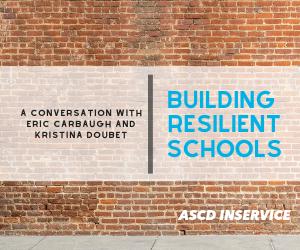Remember August? Or September? Does time feel like it’s flying by or dragging on? For many educators, October can be a difficult transitional month as the celebratory energy of the new school year gives way to multiplying—and often conflicting—priorities and challenges.
“October is a classic down month for teachers,” ASCD author Mike Anderson explains. Anderson is a frequent contributor on the topics of finding balance and sustaining motivation in educational spaces. In this podcast interview, he draws on years of experience to share practical advice for educators and leaders seeking to better support their well-being. “It’s typical for teachers and students to hit a bit of a wall. . . . Reality starts to crash in: student challenges might present themselves more prominently [and] the curriculum can start to feel overwhelming.”
Teachers, leaders, and students alike can experience a motivational slump around October. Mid-fall can offer an important moment to reassess how professional spaces support educators’ social-emotional well-being—and what might be done to increase this support more actively.
“It’s one of educators’ primary responsibilities to be healthy and well-balanced so they have the energy needed to do this incredibly demanding job,” says Anderson. Not only can teachers model a sense of balance for students, but school leaders can set examples for staff.
Modeling what it means to prioritize well-being starts from the top and can be embedded in even the smallest of education leaders’ day-to-day actions. Taking 15 minutes to step outside for a walk, setting aside consistent time for a midday meal, and connecting with positive colleagues are just a few of Anderson’s suggestions for simple goals that can have a big payoff.
Reclaiming Bandwidth
Competing priorities can create pressure to put personal well-being on the backburner and focus instead on what others need—especially when it comes to putting students’ social-emotional, behavioral, and learning needs ahead of educators’ own. But taking care of yourself first is a sign of strong leadership, according to Anderson. “It’s important for school leaders to model good health and balance because that sets a good tone for their staff . . . and because school leaders have jobs that are just as exhausting and impossible as classroom teachers or other educators.”
Taking good care of ourselves is one of the most important ways we take good care of our students.
As a leader, modeling balanced well-being is taking action because doing so signals something much larger: self-care isn’t selfish. Identifying feelings of selfishness and guilt, and putting in the work to disentangle them from self-care, can illustrate a significant shift. “Taking good care of ourselves is one of the most important ways we take good care of our students,” says Anderson.
What does it mean to take good care of ourselves? Jane Kise and Ann Holm, authors of Educator Bandwidth: How to Reclaim Your Energy, Passion, and Time, explain that educators can start by checking in on their mental and emotional capacity—what the authors call “bandwidth.” Self-reflection tools, like Kise and Holm’s free “Brain Energy and Bandwidth Survey,” can solidify nebulous concepts into concrete steps.
Our “bandwidth” is our brain energy—our mental and emotional capacity. “Think of it as the energy that powers the brain’s pre-frontal cortex—the center of executive function,” write Kise and Holm. “This small area of the brain uses a tremendous amount of energy as we work to make good decisions, focus on cognitively demanding tasks, be patient and empathetic, and engage in necessary self-care such as eating well. While these seem like completely separate activities, they all draw on the same limited pool of brain energy.”
To increase personal “bandwidth,” educators must have the resources and support available to develop and deploy balanced habits. It’s not enough to want to “power through”; instead, realistically recognizing the limits we all have on our bandwidth, paying attention to changes in our bandwidth, and setting boundaries accordingly can help us be more effective educators, write Kise and Holm.
As just one example, both Anderson and Kise/Holm identified email communication as a practical place to start. Do you check and send emails at set times of the day? Or is that inbox tab always open in your browser (and are email notifications always pinging on your phone)? Anderson suggests school leaders, especially, note what times they send emails to teachers and staff. Communicating at 2:00 a.m., even if you don’t expect a reply, can signal a lack of boundaries—when work is ever-present—and, as Kise and Holm explain, appropriate boundaries help educators improve focus and develop sustainable habits.
What might feel like a small step for some could be a significant change for others. In their study guide and throughout their book, Kise and Holm offer ideas for self-reflection, self-assessment, and self-inquiry, and encourage sharing these tools with colleagues and school communities. Increasing bandwidth, prioritizing well-being, and finding balance are personal processes but finding what works for you is worth it.
Putting Priorities into Perspective
“Why are we doing this?” that’s the question Anderson emphasizes as core to educators’ sense of purpose. When students ask “why,” it signals their investment and curiosity, and it marks a moment to engage with the bigger picture. During motivational slumps, drawing on your purpose—your “why”—can give you and your students a boost of brain energy when it’s most needed because doing so is core to reassessing and shifting priorities.
“The brain is an amazing entity,” Kise and Holm remind us. As such, it has the power to declare (as Anderson says): “my students need me to be my best self, and if I’m not my best self, I’m not being the educator I want to be.” Never is this more important than during peak times when educators are feeling the challenges of transition and change. Taking the time to reassess and rebalance is how we use our bandwidth to its fullest potential.
Educator Bandwidth: How to Reclaim Your Energy, Passion, and Time
Understanding your mental and emotional capacity—and what strategies work best to support it—begins with assessing your bandwidth.









